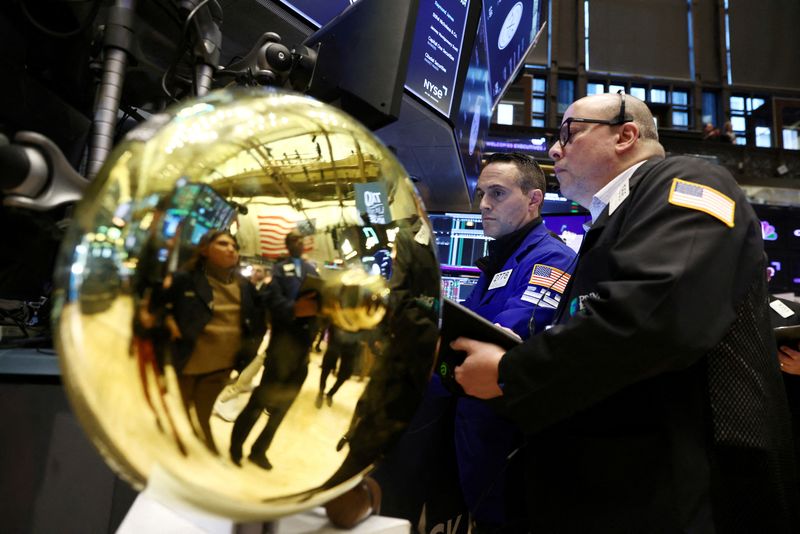By Laura Matthews
(Reuters) – Concerns that last year’s wild swings in stocks and bonds will resurface in 2023 are boosting the appeal of investments less dependent on upside in either asset class, such as managed futures and private markets.
Soaring interest rates sparked a rare lockstep tumble in equity and fixed income last year, upending traditional diversification strategies such as the 60/40 portfolio and igniting demand for investments that aim to deliver returns not correlated to broader markets.
Both stocks and bonds have bounced so far this year. Yet some market participants are convinced the Federal Reserve’s fight against inflation will keep markets volatile and are allocating funds to so-called alternative investments.
“Given everything we’re seeing right now, the current macro environment isn’t the most favorable for equities,” said Chung Ma, managing director for the Portfolio Solutions Group at Virginia Retirement System, which oversees around $100 billion.
VRS has increased its allocation to commodity trading advisors, or CTAs – funds that seek to exploit price trends in a range of asset classes – by between 20% to 25% over the past year. The fund expects to have between $300 million to $500 million in the strategies by year-end.
Ideally, such investments will generate a “stream of returns that can give you a smoother ride,” Ma said.
CTAs and managed futures funds are among several types of alternative investments that boomed amid last year’s volatility, growing their assets to $362 billion from $348 billion at the start of 2022, according to the BarclayHedge Fund Flows Indicator.
Many of the strategies notched impressive gains. The SG Trend Index, which tracks the returns of the 10 largest managed futures funds, rose 27.35% last year compared to a 19.4% fall for the S&P 500.
Those types of returns are not typical, however, and the performance of CTAs has been more muted in less volatile markets. The SG Trend index logged an average annual gain of 6.52% since 2000, compared to a 7.94% total return for the S&P 500.
“It’s not a panacea, it doesn’t work all the time,” said Maria Vassalou, co-CIO of multi-asset solutions at Goldman Sachs Asset Management. “But in times like this past year … trend following tends to do well.”
Bearish investors say markets are likely to remain choppy. Last week’s blowout U.S. employment report lifted expectations for how high the Fed will need to raise rates to cool the economy, a message reinforced by Fed Chairman Jerome Powell on Tuesday.
The S&P 500 is up 6.73% year-to-date and yields on benchmark 10-year Treasuries, which move inversely to prices, are down 16 basis points.
“While the exact trends may shift, a volatile macro environment likely persists this year,” said Jordan Brooks, principal and co-head of the Macro Strategies Group at AQR, which oversees around $100 billion. The firm’s Managed Futures Strategy HV Fund returned 50% in 2022.
Investors are also looking to private credit markets, where they hope to generate steady income, sidestep volatility and hedge against inflation by lending to private companies.
Private markets raised $216.9 billion in 2022, putting assets at $1.4 trillion as at June 2022, from $311 billion in 2010, according to data provider Preqin.
Candice Bangsund, vice-president and portfolio manager for global asset allocation at Fiera Capital, a Montreal-based asset manager with assets of approximately $118 billion, has increased allocations to private credit strategies, as well as real estate and infrastructure.
Bangsund expects the investments to yield between 5% to 8% annually in “what we anticipate will be a recessionary and potentially more volatile macroeconomic environment,” she said.
A 2023 study from State Street found that 68% of investors plan to increase their allocation to private markets in the next two to three years.
Investors in private credit markets take on their share of risk. Alternative investment firm Blackstone saw a spate of redemptions from its $69 billion unlisted real estate investment trust last year on concerns about its slowness to adjust valuations amid rising interest rates.
Vassalou, of Goldman Sachs, believes correlations between asset classes will likely revert to normal in 2023, making it easier for investors to diversify in stocks and bonds.
Others say volatility may not subside so quickly. Erik Knutzen, multi-asset chief investment officer at Neuberger Berman, believes inflation will remain comparatively high, weighing on stocks and bonds if the Fed keeps monetary policy tight. He has seen more demand for uncorrelated investments from clients in recent months.
“The new environment for a number of years to come is likely to have higher structural inflation,” he said. “In that environment, stocks and bonds are likely to be more correlated.”
(Reporting by Laura Matthews; Editing by Ira Iosebashvili and Daniel Wallis)
